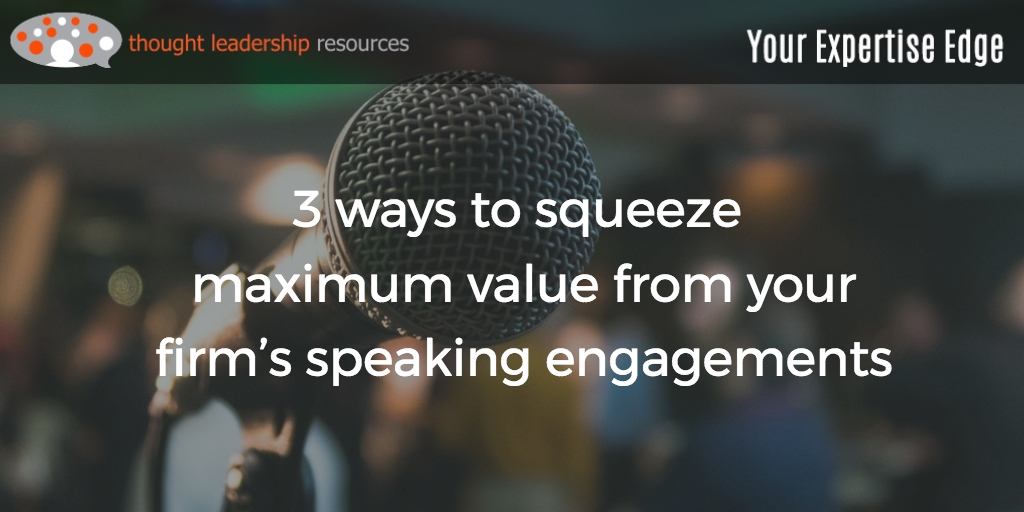And you’re left wondering – how can you get more value out of the time and effort Janet put into that presentation? Here are some simple, easy ways marketers can help business professionals get more results from the effort that went into the speech.
By the way, Post #39 talks about four benefits public speaking provides, that no other medium does.
In a word, it’s about “leverage.” Like other aspects of content marketing, a big part of success is in multiple uses of the information in the speech, across various platforms to meet your market’s various learning styles.
Here’s what you can tell Janet about three ways to get more leverage from her speech.
Spoken word to text
Start by converting the spoken words into text. There may be an as-delivered version of the presentation – which is possible only if Janet stood at the lectern and read her presentation to the audience (NOT the best way to communicate – just sayin’). Even if she did speak from a written document, there will be ideas she expressed that aren’t in the text, particularly her answers to questions from the audience.So, how do you get a “text” version of Janet’s spoken words?
It could be that the conference venue prepared audio or video recordings of presentations. These are generally provided free to the speakers. But if they don’t, you can record the presentation. You can do this easily through a lapel microphone connected to a hand-held audio recorder, or an app such as iTalk, on Janet’s smartphone. Just be sure that the battery is charged, and there’s enough storage space on the device.
An audio recording is important, because it allows you to have the presentation transcribed (maybe by low-cost transcribers in India or the Philippines) to create a text version. This can be turned into white papers, articles, blog posts and other written content. The transcription may need some editing, as what sounds good verbally doesn’t always work well on the screen or page.
Turning Janet’s spoken words into text is particularly important if she’s the kind of person who hates writing, but thrives on talking. Rather than struggle with a blank screen, go with her strength – talking.
Spoken words to video
Potential clients like to see a potential service provider in person, to get an idea of their personality. This is particularly important if Janet does most of her work long-distance, maybe never meeting her clients in person. So having a video of her presentation may help you show what she’s like in person.Some conferences provide video files on their plenary presentations, but rarely do the cameras venture into the concurrent sessions.
So, have someone with good camera skills and a good camera, take video footage of the presentation. Don’t rely on the microphone on the camera – it will pick up too much background noise. A lavalier microphone, connected to the mike jack on the camera, will produce much better sound, and you can then use the recording as a separate audio file.
However, be sure to use that video correctly. While it may be easy to sit still through an hour-long live presentation (by some speakers, anyway), a one-hour video of that speech seems way too long. As with the audio, it is best to take just the highlights, three or four minutes at a time, for a video.
As with an audio file, a transcription posted along with the video will help the content get found by search engines – and also make the information more versatile, as it meets the needs of reading-oriented people.
One speech leads to another
Use Janet’s speech to get her other opportunities to speak. As the old saying goes, “nothing succeeds like success.” Any conference planner or other venue organizer likes to have confidence that the speakers they’re booking are good and credible. Nothing says that more than having recently done a speech.
Having positive reviews, in writing, helps. Ask for them if need be – and you might even write a draft of the review for the meeting organizer, asking them to use it as a basis for whatever they want to say about that speech.
Video or audio clips, as above, help too. Having a “speaker video” that gives some samples of Janet doing presentations, can be posted to a site such as YouTube. You can then send a link to the next person you approach about scheduling a speech.
One of the strengths of video is showing that Janet is someone that her clients will want to work with. If she demonstrates that she can explain complex issues clearly and in an interesting way, there is a greater chance that prospective clients will give her preference.
So, as part of planning her next speech (my book, “Your Firm’s Expertise Edge” goes into detail about how to get speaking gigs), Janet should ask herself these questions:
• What can I do to get a video of my next presentation?
• How can I audio-record my next presentation, and then get a transcription prepared?
• How can I use that transcription, in a blog, as an article or the start of a white paper?
• Where and when is my next speaking gig, besides how will I get it?


